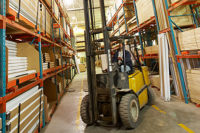Risky stunts, skydiving and SFX: Movie production safety supervisors

Behind the glitz and glamour of a Hollywood production are many familiar risks. Crews routinely work long hours, work at excessive heights, around temporary electrical wiring and sets, and on worksites that can change completely from day to day. Essentially, workers in the entertainment business face many of the same hazards as those working in construction — but with the added dangers associated with film stunts, onlookers and paparazzi breaching established security boundaries, unskilled extras, and performances using or in close proximity to live ammunition and fireworks.
I sat down with two of my colleagues at ERM to get an inside look at safety in the entertainment industry: Christopher Merrifield and Margaret Buckalew. Chris has 15 years’ experience in worker safety in the business, from writing safety procedures to auditing worksites. Margaret has provided production safety support services for multiple feature films across the U.S.
Entertainment hazards
“It’s pretty staggering what they have to know and manage,” says Merrifield. A safety professional in the entertainment business might deal with anything from machine guarding in the set-design woodshop one day, hazards associated with riots erupting around a sensitive convention covered by a news crew, and microwave and radio frequency hazards, to knowing requirements of carbon monoxide detectors in a ENG truck because of the generators operating in the rear of the truck.
Unlike other industries where there is a tribal knowledge about certain hazards, governmental guidelines for given work, and decades of applicable experience from other industries, in show business “on any one day you may be working on a set or location that has child performers, stunt workers skydiving, animal handlers, crew members filming from hot air balloons, underwater stunts and underwater operations and firearms,” says Buckalew.
Plus, “fogs, smokes and obscurants are commonly used for/in Special Effects (SPFX) during the filming of fires, explosions and large-scale effects involving airborne dust” explains Buckalew. “Polystyrene and polyurethane foams are most commonly used in set and prop construction, and they are available in different classes, fire resistant and non-fire resistant. However, under the right conditions even fire resistant foams will burn.”
Bigger stunts, bigger risks
Conventional wisdom holds that with the trend to make stunts bigger, faster and more spectacular, there is a corresponding increase in risk. Both Merrifield and Buckalew disagree. Buckalew explains, “While it is true that stunt work accounts for over half of all film-related injuries, it is rarely the stunt itself or the execution of the stunt alone that is the cause of the crew member fatality. For example, from 1980 to 1990 there were 37 deaths relating to accidents during stunts; 24 of these deaths involved the use of helicopters.” Merrifield agrees, “I know that there is a Production Safety Professional who will have some say (in how the stunt is planned and executed) and the better the safety person, the more insight on the ‘risk’ he or she is likely to have; it’s all about understanding risk and knowing the consequences with stunts. Safety professionals are dedicated to this science.”
Another very real danger in the entertainment business is one that is a growing problem in almost every industry: sleep deprivation. Sixteen-hour days are common and it’s not unusual for crew members to be on the clock for 20 or more hours. Because intensity and dedication are part of the attraction of filmmaking culture, long hours come with the territory and are generally accepted without complaint.
“Television and Feature Productions are exempt from OSHA injury and illness reporting in every state of the USA except for California,” says Buckalew. “If you are working as a production safety supervisor, you have to know the laws and restrictions related to everything being used on your location. (For example) You have to validate that the Pyrotechnic Special Effects Operator(s) hold valid State and Federal license(s), as applicable. You have to know the applicable laws surrounding firearms and ammunition, including the classification, handling, interstate transport, and DOT restrictions. It is your job to know everything about your production, all the way down to their hair and makeup. Just like contaminated site workers wearing Tyvek®, production safety supervisors have to recognize the added body burden of makeup/hair and costuming for actors and extras.”
True value
The true value of a production safety supervisor is their ability to anticipate potential safety issues and hopefully prevent problems from occurring in the first place. Whenever there are serious injuries or fatalities, it’s news, but when these things happen in the entertainment business, it goes viral. This publicity can make the entertainment industry seem far more dangerous than other industries. In reality, there are talented and highly specialized safety professionals working to reduce the risk of injuries to entertainment workers.
1 Federal OSHA exempts motion picture and video production from injury and illness recordkeeping requirements. Cal-OSHA does not exempt motion picture and video production from these recordkeeping requirements.
Looking for a reprint of this article?
From high-res PDFs to custom plaques, order your copy today!







